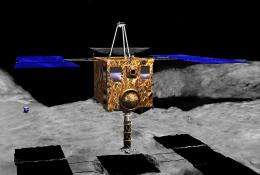June 8, 2010 report
Japanese space probe Hayabusa close to home

(PhysOrg.com) -- Hayabusa, the Japanese space probe launched in 2003, is returning home from its five-billion-kilometer round-trip journey to collect samples from the asteroid 25143 Itokawa.
According to the Japanese Space Agency, JAXA, the space probe has successfully fired its thrusters for its third Trajectory Correction Maneuver (TCM) to set it on course for a landing at the Woomera Test Range in the South Australian outback. Only one more correction maneuver remains, and is scheduled for later this week.
The spacecraft’s sample return capsule containing any samples is scheduled to detach from the probe and land at Woomera at about 1400 GMT on June 13. The US space agency, NASA, is sending a DC-8 flying laboratory from California to South Australia to record the re-entry and landing using its barrage of image and spectrographic cameras.
There is no guarantee of success of the return mission but Hayabusa has already transmitted detailed images and scientific observations from on and around the asteroid Itokawa, which will help scientists to better understand the asteroids. Until the capsule is opened scientists will not know for certain if the probe succeeded in gathering any samples, but scientists are hopeful the capsule may contain at least small residues for analysis.
The asteroid Itokawa was discovered in 1998 and named after a Japanese scientist Hideo Itokawa, a pioneer of the Japanese space program nicknamed “Dr Rocket”. It is a mere 540 meters wide and orbits about 300 million kilometers from Earth.
Hayabusa cost around 138 million USD to develop. It reached Itokawa in 2005 and landed twice to collect samples of surface materials, but it apparently failed to fire a metal bullet that was designed to dislodge samples for collection. It left behind a time capsule wrapped in film and bearing the names of 880,000 people from 149 countries who had all responded to JAXA’s public invitation to be listed.
The craft has had other problems including a leaking thruster, battery problems, broken wheels, and a fuel leak in 2005 that drained the craft’s propellant tanks, leaving only the ion thrusters to guide the craft back to Earth. The ion thrusters have low acceleration, which has meant each trajectory correction has taken longer than it would have done with the chemical engines.
The problems and malfunctions resulted in the mission lasting longer than originally planned because communications with Earth were lost for several weeks in late 2005 when the craft was due to head home. When communications were restored it was too late, and the craft had to wait until April 2007 for the positions of the asteroid and Earth to be ideal again.
Hayabusa, which means falcon in Japanese, is currently around 3,600,000 km away from Earth. The sample return capsule will land on Earth but the spacecraft itself will burn up as it re-enters Earth’s atmosphere. The mission has fueled the public imagination in Japan, and the spacecraft has a large following of fans. There are also proposals the spacecraft be granted a National Honor award.
Hayabusa is the world’s first spacecraft to land on a body other than the moon and take off again.
© 2010 PhysOrg.com

















